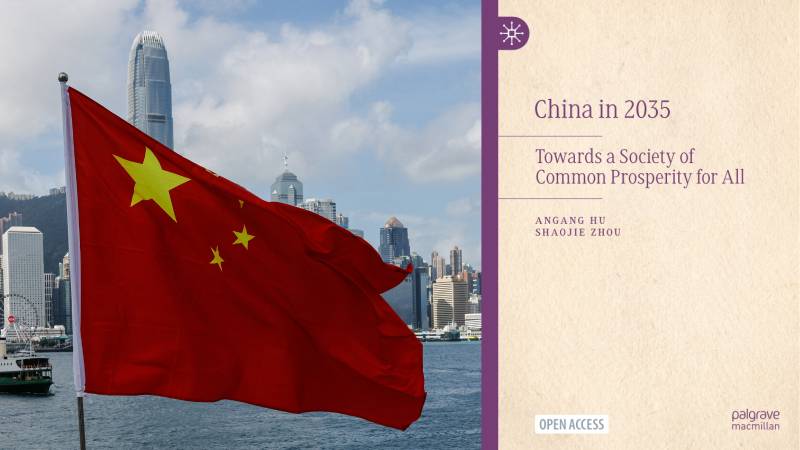
Historically, the Western portrayals of China have oscillated ‘between extremes of fantasy and contempt, dating back centuries’, while discussions about China’s rise within the capitalist world economy in the West, particularly in the United States, ‘have been rife with myths and biases’. Given these perceptions, the book China in 2035: Towards a Society of Common Prosperity for All by Angang Hu and Shaojie Zhou, professors at Tsinghua University (Palgrave Macmillan, e-book, 2024), presents a well-researched and in-depth analysis of one of the most significant socio-economic and political goals of modern China—ensuring equitable development, social justice and a fair distribution of wealth. This book is the first comprehensive analysis of the historical, theoretical, and policy dimensions of ‘common prosperity’, placing it within the broader context of Chinese- policy choices paving the way for its modernisation. It offers valuable insights into China’s developmental journey, highlighting both the triumphs and tribulations it faces in striving for economic equity.
Three outstanding features of the book are; First, it exudes positivity, laden with theoretical rigor, effective use of wide-ranging data sources, and policy prescriptions driven by theory and evidence. The book provides a wealth of diverse and authoritative sources (both Chinese & Western), including official documents, academic research, World Bank reports, and policy papers which provide a solid factual foundation and first-hand insight into the government’s long-term development strategy.
The second outstanding feature is its extensive use of comparative and tabulated data, making complex economic trends user-friendly. By presenting structured analyses of income distribution and regional development disparities, the book allows readers to grasp the scale and depth of China’s progress. Comparative tables highlighting key economic indicators, such as per capita GDP growth, income inequality measures, and employment trends, offer valuable insights into how China’s policies differ from those of other major economies. In Pakistan’s case, it evokes a comparison with Ahsan Rana’s Hain Kawakub Kuch: Capitalist Welfare System; Assumptions & Reality.
Third, from a theoretical and policy perspective, the authors explore the idea of common prosperity from a range of angles—historical, ideological, economic, political, and social. It scrutinises how the concept has evolved within Chinese socialist thought, linking it to Marxist principles while also adapting to modern economic realities. The book discusses the role of government intervention, state-market relations, and income redistribution policies, while also examining how factors such as technological innovation, demographic trends, and rural-urban migration impact China's pursuit of economic equality. It provides a nuanced and multidimensional understanding of this ambitious national goal.
The book is divided into seven chapters, systematically tracing the evolution of China’s modernisation efforts. It begins with an exploration of the origins of the concept of common prosperity, starting with Deng Xiaoping’s introduction of the idea of a “moderately prosperous society” in 1979. The book then discusses China’s remarkable achievement of eliminating absolute poverty ahead of the UN’s 2030 Sustainable Development Goals, accomplishing a critical milestone. With this foundation in place, the focus has shifted to reducing income disparities, enhancing public welfare, and promoting balanced growth across different regions. The book details the strategic policies implemented under Xi Jinping’s leadership (2012 to date) to achieve these objectives by 2035.
We have found chapters 1, 4, 5, 6 & 7 engaging, theoretically rigorous, and empirically rich and insightful. In the first chapter, the authors postulate a compelling picture of China's remarkable "poverty reduction miracle," clearly demonstrating the nation's transformation from extreme poverty to moderate prosperity. The authors cogently position the centrality of the Communist Party of China (CPC) and, the dedication of its leaders in ensuring continuity of policies, particularly through land reform, industrialisation, and targeted poverty alleviation initiatives.
By 2035, China will have significantly narrowed regional and income disparities, expanded its middle-income group, and created a more inclusive and balanced economic system—setting an example for sustainable development in the modern world
By building a theoretical framework, rigorous analysis, and supportive arguments, supplemented with empirical evidence, the CPC is projected as a ‘fundamental political guarantee’ for China’s ‘poverty reduction miracle’. It is articulated that the party adopted and pursued two principles: first, ideological line of, ‘ emancipating the mind and seeking truth from the facts’. Second, ‘putting people at the center’ is the philosophy of governance for China’s socialist path of development & common prosperity. Laden with these tools, according to the authors, China has been able to eradicate poverty and establish the world’s largest social security and social protection system. It merits attention that in 2020, China has completely lifted hundreds of millions of people out of absolute poverty for the first time in thousands of years, achieving the primary goal of the United Nations’ 2030 Sustainable Development Goals (SDG) on poverty eradication 10 years ahead of schedule. In 2022, China’s, ‘ basic medical insurance covered 1.346 billion people, and basic pension insurance covered 1.053 billion people.
The chapter efficaciously sets the stage for understanding China's current pursuit of "common prosperity," the authors declare, has the potential to become a significant new paradigm for global development. Four principles of common prosperity, emanating from the political thought of Xi Jinping are listed as: ‘encourage hard work and innovation to get rich, adhere to the basic economic system; do our best but live within our means; and adhere to gradual and orderly progress’.
Chapter 2 charts China's innovative socialist modernisation journey toward common prosperity, a path well-described giving a historical overview of Mao-Zedong, Deng Xiaoping, Jiang Zemin, and Ho Jintao eras (1949- 2012) and policies leading to the emergence of Xi Jinping. Chapter 3 analyses the foundations and challenges of common prosperity. While favorable conditions exist and the Party's strategic decision reflects national interests, achieving this ambitious goal is arduous. The authors argue that opportunities outweigh challenges, but proactively addressing risks is crucial for building a common prosperity society. Deng Xiaoping creatively proposed a roadmap for achieving common prosperity, in two steps: the first step is to “get rich first,” “let some people get rich first”; the second step is “common prosperity,” “let the ones who got rich first help those who got rich later, and eventually reaching common prosperity.”
The authors meticulously lay out China's ambitious vision for shared prosperity in Chapter 4 which explains the “Foundations and Challenges for Achieving Common Prosperity.” while simultaneously acknowledging the weighty hurdles that lie ahead. They begin by defining the characteristics of a "Chinese-style common prosperity society," emphasising higher productivity, modernisation, a richer socialist society, comprehensive human development, and a narrowing of urban-rural and regional gaps. The chapter then pivots to examine the foundations upon which this vision rests, highlighting the CPC's leadership, strategic planning, and broad social consensus.
The authors analyse China's economic capacity to achieve these goals, projecting significant growth in GDP, per capita income, and labor productivity. They underscore the country's favorable conditions, including high savings and labor participation rates, alongside increasing contributions from scientific and technological progress. Cognizant of academic objectivity, the chapter doesn't shy away from the challenges. It identifies key issues such as the persistent needs of tens of millions of people, a severe lack of national redistribution capacity due to declining fiscal revenue, and the complexities of managing a vast and diverse population. China must forge its path while navigating these intricate challenges, thus emphasising the need to address the main social contradiction of unbalanced development and the growing demand for a better life, framing it as a central challenge for the nation. By 2050, China aims to achieve ‘common prosperity, and the 14th Five-Year Plan is indicated as imperative for achieving initial milestones. To this effect, the authors provide ample data and statistical analysis in Chapter 5 to outline strategic goals involving phased progress, focusing on increased productivity, improved living standards, and reduced inequality.
Chapters 6 and 7 lay out a comprehensive, if ambitious, policy roadmap for achieving common prosperity, with its emphasis on action plans and employment prioritisation being particularly crucial. The focus on income distribution and demographic challenges is commendable and the chapters adequately addresses the potential complexities of implementation. China's pursuit of common prosperity is provocatively presented as a transformative global project, building upon its already impressive achievements.
Beyond data, the book provides a clear roadmap for policy implementation, outlining key strategies such as rural revitalisation, income redistribution, and improvements in basic public services. The discussion on income distribution reform is particularly insightful, as it explores how China seeks to balance economic growth with social equity. The book also acknowledges the challenges ahead, including regional economic imbalances, the urban-rural divide, and demographic shifts that could impact long-term policy outcomes. Importantly, it convincingly argues that China’s governance model and long-term strategic planning provide it with the necessary tools to address these issues effectively. Will this China model attract nations in the Global South?
In our assessment, China in 2035 is an insightful and well-structured work that offers a deep dive into one of China’s most ambitious policy goals. Its use of diverse sources, extensive data, and comparative analysis makes it an invaluable resource for scholars, policymakers, China skeptics, and anyone interested in understanding China’s economic strategy.
The book skillfully weaves historical context with contemporary policy analysis, making it an essential read for those seeking to understand China’s path to a more equitable and prosperous society. The authors suggest that by 2035, China will have significantly narrowed regional and income disparities, expanded its middle-income group, and created a more inclusive and balanced economic system—setting an example for sustainable development in the modern world. It is a must-read for Pakistani political leaders, economists, and development practitioners. The key lesson for Pakistan is to dismantle and avoid harmful regulations while designing innovative, sustainable, and people-centric welfare policies that reflect broad national consensus.

